Hiking, an exciting travel, enables people to embrace nature, meet new friends, and enrich their life. Do you want to have a try? Our 8 Days China hiking tour will be the best choice. It contains a myriad of historical sites such as Three Pagodas of the Chongsheng Temple, Dali Old Town, Mufu Palace and Songzanlin Monastery. Of course, enchanted natural landscapes in your China hiking tour to Yunnan are accessible. For example, Erhai Lake, Jade Dragon Snow Mountain, Black Dragon Pool Park and Potatso National Park will be in your sight. During your tiger leaping gorge hiking tour in Lijiang, you will hike the challenging 28 bends and climb a ladder attached to the vertical cliff to the peak of the Middle Section of Tiger Leaping Gorge. When you are at its peak, the bird’s view that the lucid Jinsha River is like a jade belt lying between Jade Dragon Snow Mountain and Haba Snow Mountain is available. How stunning the scenery is! So come and choose us, I am sure that you will never forget the wonderful times in the China hiking journey.

Welcome to Kunming, the capital of southern China’s Yunnan Province. It is home to more than 6 million people and covers an area of over 2,600 square kilometers. Crowned as Spring City domestically and around the world, Kunming represents an international tourism city, enjoying sunny and warm weather throughout the year.
Upon your arrival, your guide will pick you up at the airport. Then you will be driven to the hotel where your amicable guide will help you to check in. You can have a good rest so as to be prepared for the following wonderful days.
 Dali
Dali With breakfast, you will take the Estimated Train G8673 09:04/11:26 to Dali. Stuck in eastern Yunnan Province, it is characterized by its engaging scenery. Upon your arrival, your guide will take you to a restaurant where a delicious lunch is offered.
In the afternoon, let’s start to explore some must-go tourist attractions in Dali. Three Pagodas of the Chongsheng Temple will be a good outset of your China Hiking Tour to Yunnan. Located at the east foot of the Cang Mountains and facing the west shore of the Erhai Lake, they are an ensemble of three independent pagodas respectively arranged on the corners of a symmetric triangle. Among them, the main pagoda is known as Qianxun Pagoda, which was reportedly built during 823-840 AD and is composed of sixteen floors with a height of 69.13 meters. The other two sibling pagodas stand respectively in the northeast and southwest of Quanxun Pagoda, both of which are 42.19 meters high. The three pagodas were not only built to promote Buddhism but also for auspicious reasons. According to a legend, Dali was once a swamp where the dragons that were thought to create natural disasters inhabited. Since dragons fear pagodas, the three stately pagodas were built to deter the evil dragons.
Next, you will visit Dali Old Town. Stuck at the foot of the dreamy Cang Mountains, it used to be the capital of the ancient Kingdom of Nanzhao (738-902) and the Kingdom of Dali (937-1253). Dali Old Town has four gates. Among the four gates in the old town, the South Gate is the most renowned, with a history of over 600 years. Also known as Double Crane Gate, it is the only gate behind which there is a Buddhist niche in China. That’s because, in the 317-year history of the Kingdom of Dali, the people throughout the whole country were Buddhists. The streets in the town follow a chessboard layout, with five traversing from south to north and eight traversing from west to east. Local people are particularly fond of growing flowers and trees, which has even become a traditional local custom. Almost every household is equipped with a garden where the precious camellias and azaleas are planted. Some flowers in full bloom are even sticking out of the wall. Walking on the streets permeated with the fragrance of the flowers, you will feel a classic beauty.

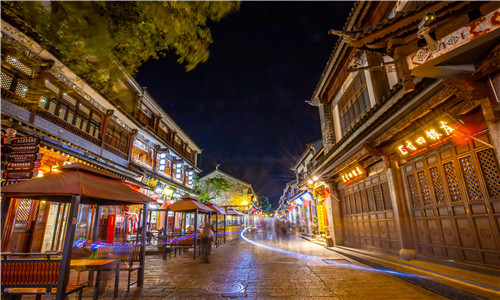
 Lijiang
Lijiang Starting a day with a palatable breakfast, you will leave for Erhai Lake. Erhai means ear-shaped sea by dint of its shape as seen by locals. With an area of 250 square kilometers, Erhai Lake is the second largest highland lake in China. When taking a boat floating on its rippling surface, you can see a cloud band that has a dreamy name, Jade Belt Cloud. It is elegant, like a soft white yarn tied to the Cang Mountains. Aside from its ethereal beauty, there is also a beautiful yet heartbreaking love story about Jade Belt Cloud, the main characters of which are a man named Bai Lang and a fairy named Yu Nü. In ancient times, Erhai Lake was as beautiful as a fairyland. In order to get a better view of the lake, Yu Nü, who was dressed in colorful ribands, came to Cang Mountains (opposite the Erhai Lake). One day, she met Bai Lang, an emaciated orphan who quarried precious stones all day to make a living. Knowing about Bai Lang’s experiences, Yu Nü decided to accompany him to find costly stones every day. Gradually they fell in love with each other and spent wonderful days together. As Yu Nü was a fairy, she had to return to Heaven. When it came to the time that they should depart, Bai Lang did not want her to go away, thereby holding her colorful ribands tightly. Though loving Bai Lang very much, Yu Nü had finally left. She used her magic to make one of her ribands into a long jade cloud belt on the Cang Mountains so that Bai Lang could not forget her as long as he saw the cloud belt.
After enjoying lunch, you will be driven to Lijiang towards the north. It takes around 2.5 hours(165KM). Upon arrival, you are going to start your journey in Lijiang.
The scenic spot to be visited this afternoon is Lijiang Ancient Town. Surrounded by fields, mountains, and rivers, it dazzles with cultures and liveness. Unlike other ancient towns in China, Lijiang Ancient Town has no walls. Here are two reasons. Firstly, built on flat land at an altitude of more than 2,400 meters, it is surrounded by mountains on three sides, all of which serve as protectors for the ancient town. Secondly, the original ruler of the ancient city of Lijiang was named Mu. If they add a wall to the Lijiang Ancient Town, it is like adding a frame to the character “Mu” (木), and it becomes the character “Kun”(困). In Chinese, the word Kun means trapped. It is unlucky. As such, there is no need to build city walls.
People often say no one can visit Lijiang without visiting Mufu Palace, one of the most eye-striking attractions in the ancient town. Facing the east, it was built for the Chieftain Mu in Lijiang, whose family had gone through 22 generations and 470 years during the Yuan (1271-1368), Ming, and Qing Dynasties. At its heyday, the Mufu Palace even covered an area of over 60,000 square meters, with about 100 spectacular buildings. Unluckily, most of the buildings were destroyed in the late Qing Dynasty (1636-1912). Today’s Mufu Palace occupies an area of 30,000 square meters, with its central axis being 369 meters long. Although Mufu Palace is only a mansion of a chieftain, its beauty is comparable to that of any royal residence. Inside the palace, there is a building called Wanjuan Hall. It has a rich cultural heritage with thousands of Dongba Sutra, hundreds of Tibetan Sutra as well as famous paintings and calligraphy.
An added attraction is Sifang Street Square. Stuck in the center of Lijiang Ancient Town, it was allegedly built in the shape of Chieftain Mu’s seal of the Ming Dynasty (1368-1644), surrounded by small alleys. Since the Ming and Qing Dynasties, merchants from different areas have gathered here, leading to the booming of cultural exchange. All buildings along the street are made of brick and wood. Their doors, windows, and cornices are carved with the patterns of flowers, birds, fishes as well as beasts. With small bridges, flowing water, green trees, and beautiful flowers, Sifang Street Square itself is a picturesque park. Besides, the streets are full of bars, which makes Lijiang a “Romance City”. Among them, One Meter Sunshine Bar and Sakura Cafe Bar are the most famous, where you can be immersed in the bar culture.


Today, let’s continue to explore some tourist attractions in Lijiang. With breakfast, you will be driven north for about fifty minutes to Jade Dragon Snow Mountain by car, about 20 kilometers away from Lijiang’s urban area. That means your China hiking tour to Jade Dragon Snow Mountain start!
Composed of 13 peaks with an altitude of at least 4,800 kilometers, Jade Dragon Snow Mountain stretches a length of 75 kilometers. It is home to a wide array of rare species of fauna and flora. About a quarter of plant species can be found here. As the continuous snowy mountains surrounded by white clouds look like a jade dragon, hence its name. About the engaging snow-covered mountains, there is an archaic legend. A long time ago, twin brothers, Jade Dragon Snow Mountain and Haba Snow Mountain had lived a happy life with their friend Jinsha River until a devil destroyed the river. To protect the Jinsha River, the brave brothers fought fiercely with the devil. The result was that Haba was injured and Jade Dragon chased away the devil with his thirteen swords. In a bid to prevent the devil from returning and protect the local Naxi people, Jade Dragon held all his swords all day long. With time passing, the courageous brothers became two snowy mountains and the thirteen swords turned into thirteen peaks. Therefore, Jade Dragon Snow Mountain is considered the incarnation of “San Duo”, the protector of the local Naxi people.
Taking the cable car, you will go to Spruce Meadow, with an altitude of 3,240 meters. It is not only a viewing place where the majestic view of Jade Dragon Snow Mountain is available but also is considered the land of dying for love. According to a legend, due to the feudal system of polygamy, a man was supposed to take several wives. Yearning for true love and to escape from the arranged marriages and feudal ethics, the first couple of Naxi lovers decided to die for love at Spruce Meadow. Later, at the Torch Festival in June, young men and women settled in villages near Jade Dragon Mountain will come to Spruce Meadow, mourning for the first couple of Naxi lovers. Around the Spruce Meadow, there are often some girls in folk costumes singing and dancing, adding cultural charm to the meadow. Among them, Naxi girls wear costumes embroidered with the pattern of the star and moon.
After that, you will go down the mountains by cable car to visit Blue Moon Valley. As its name tells, it is endowed with a blue lake and crescent-shaped valley. Besides, it is allegedly the prototype of the blue moon valley in the lost horizon by British writer James Hilton. Its azure lake adds charm to the ambient stunning mountains full of exuberant trees. Entering the valley, you can hear the sound of gently gurgling streams, and the tweet of the rare animals in the mountains. When the sunshine reaches the blue lake and a gentle breeze blow, sparkling waves will be formed. What an engaging scenery it is!
After lunch, let’s take you south for about half an hour to Baisha Ancient Town by car, about 24 kilometers away from Jade Dragon Snow Mountain. In the ancient town, you can see the invaluable Baisha Mural Paintings. The mural paintings are an eclectic mix of religious cultures and artistic genres, the contents of which include running horses, blooming lotuses, flying birds, and so on. There is a palace called Dabaoji Palace. It houses the largest number of murals in Lijiang. With vivid figures and bright colors, the murals integrate the culture of Tibetan Buddhism, Confucianism, and Taoism. Seeing these, you will certainly admire the superb artistic skills and outstanding creativity of these excellent craftsmen behind the murals.
Next, Black Dragon Pool Park is your destination. It is in the south of and about 10 kilometers away from Baisha Ancient Town. You will spend about 20 minutes getting there by car. Built in 1737, it is 2,500 meters above sea level. About Black Dragon Pool Park, there are many legends. Take one legend as an example. A long time ago, the grass with the magic of making a man immortal was planted at the bottom of the Black Dragon Pool. A man called Hai Lan employed by a demanding landlord was ordered to plant trees near the Black Dragon Pool. As time passed, the lakeside was full of green trees and became very beautiful. One day, when planting trees, he met a fairy who lived at the bottom of the lake, who told him the grass with the magic. Unfortunately, the landlord knew about the magical grass and ordered Hai Lan to steal it. Pretending to consent, Hai Lan let the fairy use her magic to conjure a similar grass that could turn a man into a tortoise. Later, Hai Lan took the grass to the landlord. Eating it, the landlord eventually became a tortoise. Therefrom, the fairy married Hai Lan and they lived a happy life.
Today’s last scenic spot is Dongba Culture Museum, which was founded in 1984. "Dongba" is the name of a traditional Naxi religious clergyman, meaning the most senior intellectual of the Naxi people. Most of them are good at singing, dancing, scriptures, history, painting, and medicine. Therefore, the museum can be considered the epitome of the Naxi culture. It is based on the surrounding landscape and the main buildings follow the style of the Naxi Siheyuan (a courtyard surrounded by buildings on all four sides). In the museum, you can see the records of religious rituals such as the "Heaven Sacrifice" and "Wind Sacrifice". On top of that, a wide array of scriptures, paintings, handicrafts, manuscripts as well as household goods of the Naxi People are collected in the museum, which can help you know more about Dongba culture.
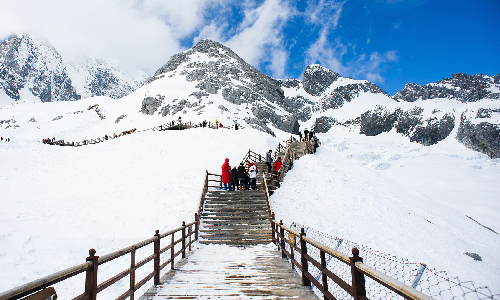
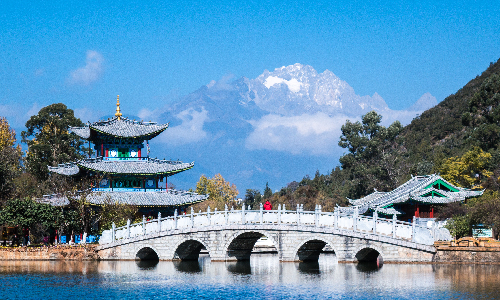
 Tiger Leaping Gorge
Tiger Leaping Gorge After breakfast, you will be driven north for about 2.5 hours to Tiger Leaping Gorge by car, about 95 kilometers away from Lijiang’s urban area. With the depth maximizing about 3,900 meters, Tiger Leaping Gorge is one of the deepest and most majestic canyons in the world.
Today, your Tiger Leaping Gorge Hiking Tour begins. The hiking tour can be divided into three parts. Starting from the Qiaotou Village, you will spend about one hour walking to the Naxi Family Guest House at an altitude of 2,200 meters, where you can enjoy your lunch and have enough rest. Along the way, you will cross the Jinsha River where you can see a rapid flowing down the valley. And then you will reach 28 Bends. This is where the harder part begins. During this part, the road is zigzag-shaped and the mountains are more precipitous, which needs you to put more effort. When you pass the 28 bends, the altitude will increase by 450 meters. Later, after two hours’ walk, you will arrive at Tea Horse Guesthouse in Yongsheng village where a delicious dinner is offered and you can sleep tight. At night, what you need to do is relieve yourself and look forward to tomorrow’s hiking trip!
Notice:
In order to ensure that you have a safe and wonderful hiking trip, the suggestions are listed as follows:
1. Keep your eye on the dangerous road.
2. Wear outdoor jackets, quick-drying clothes, and waterproof and non-slip hiking shoes.
3. Apply some sunscreen cream.
4. Don’t eat too much.
5. Travel and pack light.

 Shangri-La
Shangri-La Today, let’s continue the hiking tour! With breakfast in the Tea Horse Guesthouse, you will hike for two hours to TINA Guesthouse. You can have enough rest here.
Then, the most stimulating about-four-hour route starts. You will climb a ladder attached to the vertical cliff to the Middle Section of Tiger Leaping Gorge. It is quite steep, almost parallel to the cliff. You must save enough energy before starting this challenging path and be more careful. On the way up, clusters of flowers and soft white clouds will be in your sight. The higher you climb up, the more you feel like being in a fairyland. Are you ready to conquer it? When you arrive at the peak of the Middle Section of Tiger Leaping Gorge, you will find it is worth the climb. The fresh and moist air makes you feel more comfortable. In addition, the crystal clear Jinsha River is like a jade belt, located between the Jade Dragon Snow Mountain at an altitude of 5,596 meters and the Haba Snow Mountain at an altitude of 5,396 meters. People call this scenery One-Line-Sky (the landform of a narrow passage between huge rocks). When the treacherous water constantly hits the rocks on the banks of the river, a loud boom like a symphony will be produced. You will marvel at the spectacular scenery.
After that, you will hike back to TINA Guesthouse for a rest. Then, let’s drive you northwest for about 2.3 hours to Shangri-La, around 114 kilometers away from Tiger Leaping Gorge.
Today, let’s start to explore Shangri-La. Songzanlin Monastery will be your destination this morning. Founded in 1679, it represents the largest Tibetan Buddhist monastery in Yunnan Province and is also known as “Small Potala Palace”. It is a fusion of Tibetan and Han architectural styles. The monastery has six main buildings, with murals that are brightly colored. Its entrance gate is at the foot of the mountain, through which you can have access to the main hall by climbing up 146 steps.
After lunch, you will go to Potatso National Park. Located at an altitude between 3,500 and 4,159 meters and covering an area of about 1,313 square kilometers, it is a fusion of lakes, wetlands, forests, meadows, valleys, and streams. It is also home to a mixed assortment of rare animals and plants. Thanks to the abundant rainfall, the park enjoys pleasant weather. Sometimes with the misty clouds, it looks like a fairyland, as if the clouds can lift you from the ground. In the park, there are many famous scenic spots. Bita Lake is a case in point, which is famed for its masses and mountains of azalea trees. When the azaleas’ petals fall into the lake, the fishes that eat the petals will be on their back with the belly up. This scenery is known as “fish getting drunk by azalea”. There is a circular island in the lake, which is known as a "plant gene pool" because of its rich variety of vegetation. In a world, in the Potatso National Park, you can embrace nature closely, submerging yourself in the perfume of the flowers and the cheerful singing of the birds!
Notice:
When visiting Songzanlin Monastery, you should pay attention to the following tips:
1. Do not wear sunglasses and hats when entering the main hall of the monastery.
2. Do not step on the threshold in the monastery.
3. Rotate a prayer wheel in clockwise order.
4. No photos.
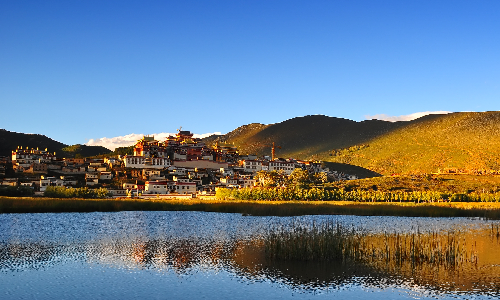
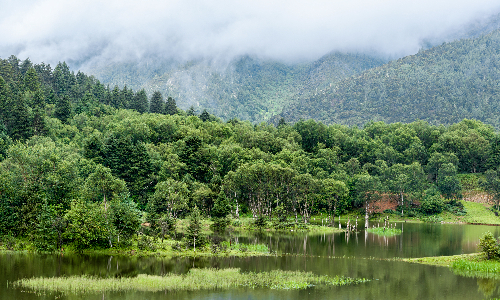
After breakfast, you will be transferred to the airport. See you next time!
Author: Xie Peng
Proofreader: Lexie
| City | Five Star hotel list | Four Star hotel list |
|---|---|---|
| Kunming | Grand Park Kunming | UChoice Hotel |
| Dali | The One Hotels & Resorts | Landscape Hotel |
| Lijiang | Wonderport International Hotel | Lijiang Wangfu Hotel |
| Shangri-La | Paradise Hotel | Ri Yue Xing Cheng Hotel |
 |
![]() About your child or infant, please contact us for a discounted price.
About your child or infant, please contact us for a discounted price.



We started with a few days in Beijing & ended in Shanghai, from where we visited the Forbidden City and Great Wall. In between we visited Terra Cotta Warriors Museum, Panda Base, Shanghai Disneyland.

We had a wonderful holiday in China which will remain long in the memory. China is a breathtakingly beautiful country full of splendid temples and palaces, mountains and rivers, peaceful rural scenes and bustling shopping streets.
 QUICK ENQUIRY
QUICK ENQUIRY